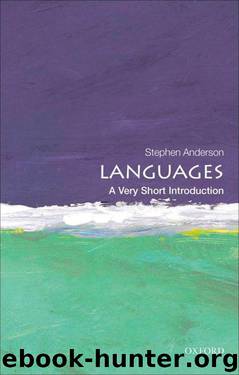Languages: A Very Short Introduction (Very Short Introductions) by Stephen Anderson

Author:Stephen Anderson [Anderson, Stephen]
Language: eng
Format: epub, mobi
Publisher: Oxford University Press
Published: 2012-06-27T16:00:00+00:00
Differentiating languages from one another
One common-sense notion of when we are dealing with different languages, as opposed to different forms of the same language, is the criterion of mutual intelligibility: if the speakers of A can understand the speakers of B without difficulty, A and B must be the same language. This is the basic principle that Ethnologue uses to distinguish languages, although they are not completely consistent in applying it. For instance, the language listing for Switzerland includes ‘Swiss German’, distinct from standard German and treated as one language. Nonetheless, they note that ‘[e]ach canton has [a] separate variety, many mutually unintelligible’. In fact, there are many more varieties of Swiss German than there are cantons, and some of these are indeed mutually unintelligible to a significant extent, and so ought properly to have been treated as separate languages if this criterion were taken literally. Apparently, one has to stop the fragmentation somewhere, but the result is somewhat problematic.
In fact, the notion of separating languages on the basis of mutual intelligibility is very similar to the ‘biological species’ concept mentioned in Chapter 1, on which organisms are assigned to different species to the extent they cannot reproduce with one another. While widely accepted, that notion also has its problems. Some of these are unique to the biological context: for instance, horses and donkeys are assigned to separate species, but in fact they can reproduce with one another, yielding either mules (if the father is a donkey and the mother a horse) or hinnies (in the reverse case). Mules and hinnies, on the other hand, are generally infertile and cannot reproduce with horses, donkeys, or each other. To what species do these animals belong? And is it relevant that a small number of female mules actually have produced offspring with male horses or donkeys? Fortunately, we do not have to resolve comparable conundrums in the case of languages.
Just as the biological species concept does not yield a completely clean division of organisms into species, so the notion of mutual intelligibility also fails in practice to cut the world up into clearly distinct language units. The problems are not precisely parallel, of course. Mutual intelligibility among languages is a somewhat gradient phenomenon (Catalan speakers and Spanish speakers without a background in the others’ language cannot completely understand one another, but either can understand more of the other language than they could understand from a monolingual Japanese tourist), while reproductive isolation is much more nearly categorical. But there are some interesting similarities.
In some instances, speakers of A can understand B, but not vice versa, or at least speakers of B will insist that they cannot understand A. In some instances, these asymmetries are probably quite real. Among the Scandinavian languages, native speakers of Danish generally report being able to understand a great deal of what is said in (Riksmål) Norwegian, which is not surprising, given that this language has its origin in the Danish spoken in Norway as a standard under Danish rule of the country from the 16th through the early 19th century.
Download
Languages: A Very Short Introduction (Very Short Introductions) by Stephen Anderson.mobi
This site does not store any files on its server. We only index and link to content provided by other sites. Please contact the content providers to delete copyright contents if any and email us, we'll remove relevant links or contents immediately.
Cecilia; Or, Memoirs of an Heiress — Volume 1 by Fanny Burney(32434)
Cecilia; Or, Memoirs of an Heiress — Volume 2 by Fanny Burney(31868)
Cecilia; Or, Memoirs of an Heiress — Volume 3 by Fanny Burney(31851)
The Lost Art of Listening by Michael P. Nichols(7403)
Asking the Right Questions: A Guide to Critical Thinking by M. Neil Browne & Stuart M. Keeley(5630)
We Need to Talk by Celeste Headlee(5542)
On Writing A Memoir of the Craft by Stephen King(4863)
Dialogue by Robert McKee(4321)
Pre-Suasion: A Revolutionary Way to Influence and Persuade by Robert Cialdini(4142)
I Have Something to Say: Mastering the Art of Public Speaking in an Age of Disconnection by John Bowe(3838)
Elements of Style 2017 by Richard De A'Morelli(3306)
The Book of Human Emotions by Tiffany Watt Smith(3236)
Fluent Forever: How to Learn Any Language Fast and Never Forget It by Gabriel Wyner(3024)
Name Book, The: Over 10,000 Names--Their Meanings, Origins, and Spiritual Significance by Astoria Dorothy(2938)
Good Humor, Bad Taste: A Sociology of the Joke by Kuipers Giselinde(2902)
Why I Write by George Orwell(2874)
The Art Of Deception by Kevin Mitnick(2735)
The Grammaring Guide to English Grammar with Exercises by Péter Simon(2706)
Ancient Worlds by Michael Scott(2622)
